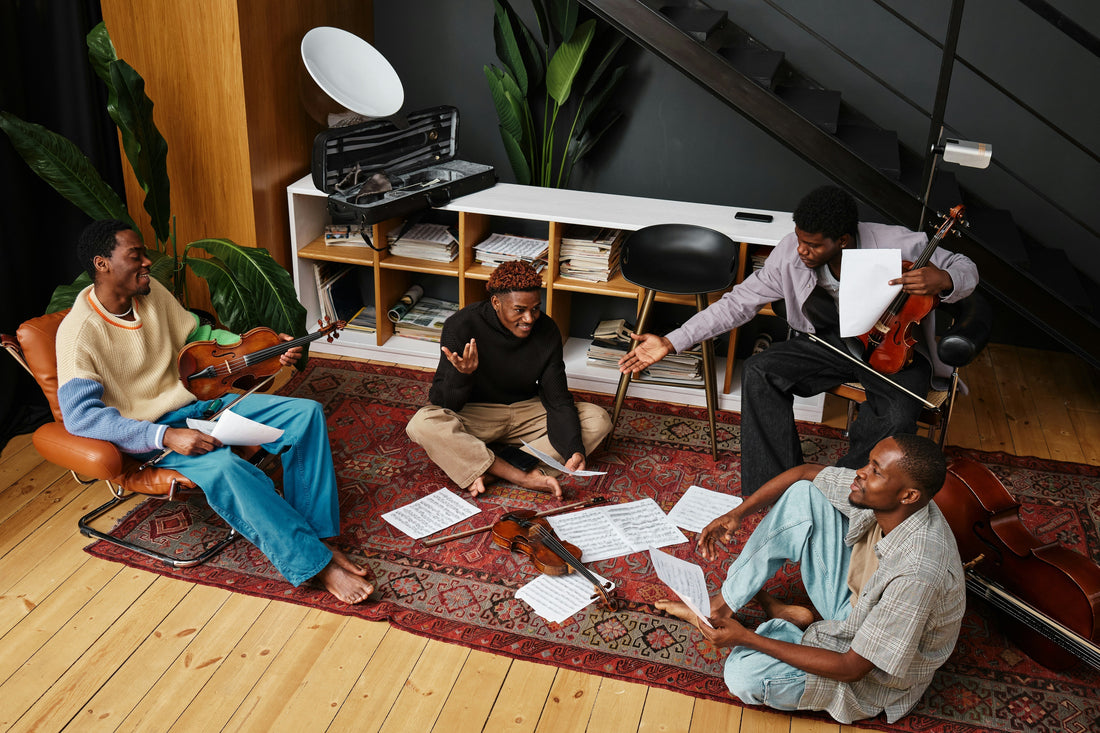
Part 5- Communal Vibes: Music as a Shared Experience
Share
The practice of music listening varies between individual contemplation and loud communal celebration. People from different times and cultures have united through music while dancing together or while listening to music in their homes and during weddings and protests and street corners. The following section investigates communal musical effects alongside the ways that synchronized listening activities build group connections.
The Living Room Concert
People used to gather together for music events by listening to radios and playing records and watching TV music shows before the advent of streaming and Bluetooth speakers. Many families today establish musical traditions which include Sunday jazz sessions and Friday night dance parties and extended karaoke sessions.

We play salsa music in the kitchen with my family every Friday during our cooking time. Our family uses music as a way to relax together. – Lucía, 38, Miami
Music in Ceremony and Ritual
Music plays a vital role in various cultures when it comes to important life events such as births, weddings, funerals and religious ceremonies. Certain songs and musical elements from previous generations accompany these special occasions.

India: Classical ragas played at weddings and religious festivals

West Africa: Drumming and call-and-response singing at naming ceremonies

Indigenous North America: Powwow songs and dances as acts of cultural preservation

We played his favorite jazz records at my grandfather's funeral service. The music created an illusion that his spirit remained present with us. – Marcus, 45, New Orleans
The Power of the Crowd
Live concerts and festivals generate an unmatched atmosphere of energy which people can experience firsthand. A crowd of strangers united by joint singing produces feelings of unity that transcend their individual languages and cultural origins.

Glastonbury: Mud, music, and magic
Coachella: A cultural moment as much as a musical one
Notting Hill Carnival: Sound systems, steel drums, and street celebration
During the performance of the chorus I felt goosebumps when the entire audience joined their voices together. We became part of a larger group that transcended our individual backgrounds. – Ella, 27, London
Music on the Move
Music functions as a common audio companion for people who are moving through roads and public transport systems. The transportation network of buses and taxis in numerous cities operate as musical performance centers.
The music played in Nairobi matatus reaches extremely high decibel levels. The musical experience forms an integral part of the cultural heritage. – Brian, 31, Nairobi

Protest and Resistance
Through music people have used it as a tool to demonstrate their resistance while uniting with others in protest. Musical anthems from various genres unite different voices to support various social causes.
USA: “We Shall Overcome” during the Civil Rights Movement
South Africa: Anti-apartheid songs sung in the streets
Chile: Nueva canción as a form of resistance
The protest march became more united when we started singing together. It gave us courage.” – Sofía, 22, Santiago
Why Shared Listening Matters
Communal music rituals:
- Strengthen bonds
- Preserve culture
- Create collective memory
- Offer joy, healing, and resistance
Part 5 – Communal Vibes Playlist
- Fela Kuti – Water No Get Enemy
- ABBA – Dancing Queen
- BTS – Dynamite
- Bob Marley – One Love
Show Us Your Vibe
Do you have a favorite communal music memory?
A family tradition, a festival moment, a protest song?
Share your story or photo with #ListeningRituals
Next Up:
Part 6 – Your Rituals: A Global Listening Diary
A collection of stories from readers around the world.
